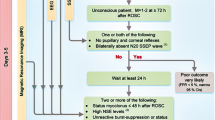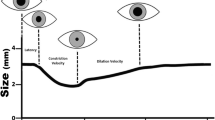Abstract
Background/Objective
The corneal reflex assesses the integrity of the trigeminal and facial cranial nerves. This brainstem reflex is fundamental in neuroprognostication after cardiac arrest and in brain death determination. We sought to investigate corneal reflex testing methods among neurologists and general critical care providers in the context of neuroprognostication following cardiac arrest.
Methods
This is an international cross-sectional study disseminated to members of the Neurocritical Care Society, Society of Critical Care Medicine, and American Academy of Neurology. We utilized an open Web-based survey (Qualtrics®, Provo, UT, USA) to disseminate 26 questions regarding neuroprognostication practices following cardiac arrest, in which 3 questions pertained to corneal reflex testing. Descriptive statistical measures were used, and subgroup analyses performed between neurologists and non-neurologists. Questions were not mandatory; therefore, the percentages were relative to the number of respondents for each question.
Results
There were 959 respondents in total. Physicians comprised 85.1% of practitioners (762 out of 895), of which 55% (419) identified themselves as non-neurologists and 45% (343) as neurologists. Among physicians, 85.9% (608 out of 708) deemed corneal reflex relevant for prognostication following cardiac arrest (neurologists 84.4% versus non-neurologists 87.0%). A variety of techniques were employed for corneal reflex testing, the most common being “light cotton touch” (59.2%), followed by “cotton-tipped applicator with pressure” (23.9%), “saline or water squirt” (15.9%), and “puff of air” (1.0%). There were no significant differences in the methods for testing between neurologists and non-neurologists (p = 0.52). The location of stimulus application was variable, and 26.1% of physicians (148/567) apply the stimulus on the temporal conjunctiva rather than on the cornea itself.
Conclusions
Corneal reflex testing remains a cornerstone of the coma exam and is commonly used in neuroprognostication of unconscious cardiac arrest survivors and in brain death determination. A wide variability of techniques is noted among practitioners, including some that may provide suboptimal stimulation of corneal nerve endings. Imprecise testing in this setting may lead to inaccuracies in critical settings, which carries significant consequences such as guiding decisions of care limitations, misdiagnosis of brain death, and loss of public trust.


Similar content being viewed by others
References
Posner JB, Saper CB, Schiff N, Plum F. Plum and Posner’s diagnosis of stupor and coma. 4th ed. New York: Oxford University Press; 2007.
Ropper AH, Gress DR, Diringer MN, Green DM, Mayer SA, Bleck TP. Neurological and neurosurgical intensive care. 4th ed. Philadelphia: Lippincott Williams & Wilkins; 2004.
Wijdicks EF, Bamlet WR, Maramattom BV, Manno EM, McClelland RL. Validation of a New Coma Scale: the Four Score. Ann Neurol. 2005;58:585–93.
Wijdicks EF, Varelas PN, Gronseth GS, Greer DM. Evidence-based guideline update: determining brain death in adults: report of the Quality Standards Subcommittee of the American Academy of Neurology. Neurology. 2010;74:1911–8.
Wijdicks EF, Hijdra A, Young GB, Bassetti CL, Wiebe S. Quality standards subcommittee of the American Academy of N Practice parameter: prediction of outcome in comatose survivors after cardiopulmonary resuscitation (an evidence-based review): report of the Quality Standards Subcommittee of the American Academy of Neurology. Neurology. 2006;67:203–10.
Callaway CW, Donnino MW, Fink EL, et al. Part 8: post-Cardiac Arrest Care: 2015 American Heart Association Guidelines Update for cardiopulmonary resuscitation and emergency cardiovascular care. Circulation. 2015;132:S465–82.
Rossetti AO, Rabinstein AA, Oddo M. Neurological prognostication of outcome in patients in coma after cardiac arrest. Lancet Neurol. 2016;15(6):597–609.
Aramideh M, Ongerboer de Visser BW, Koelman JH, Majoie CB, Holstege G. The late blink reflex response abnormality due to lesion of the lateral tegmental field. Brain. 1997;120(Pt 9):1685–92.
Eysenbach G. Improving the quality of web surveys: the checklist for reporting results of internet e-surveys (CHERRIES). J Med Internet Res. 2004;6:e34.
Yang AY, Chow J, Liu J. Corneal innervation and sensation: the eye and beyond. Yale J Biol Med. 2018;91:13–21.
Esteban A. A neurophysiological approach to brainstem reflexes. Blink reflex. Clin Neurophysiol. 1999;29:7–38.
Acosta MC, Tan ME, Belmonte C, Gallar J. Sensations evoked by selective mechanical, chemical, and thermal stimulation of the conjunctiva and cornea. Investig Ophthalmol Vis Sci. 2001;42:2063–7.
Gardner HB. The corneal reflex the most reliable guide in anaesthesia. Br Med J. 1905;1:244–5.
Acknowledgements
Dr. Carolina B. Maciel has received the Claude D. Pepper Older Americans Independence Center Junior Scholar award that supports pre-clinical studies of mechanisms of secondary brain injury in a rodent cardiac arrest model.
Funding
This study was supported by the Department of Neurology of Yale University.
Author information
Authors and Affiliations
Contributions
CBM, MMB, TSY and DMG conceived the presented study and developed the survey. CBM and TSY drafted the manuscript. JJT and MBD provided critical contributions to data analyses. All authors revised to provide critical contributions to the final manuscript.
Corresponding author
Ethics declarations
Conflict of interest
Dr. Maciel, Dr. Youn, Dr. Barden, Ms. Zhou, Dr. Pontes-Neto, Dr. Silva, Dr. Theriot, and Dr. Greer have nothing to disclose. Dr. Dhakar reports personal fees from Adamas Pharmaceuticals, other from UCB Biopharma, other from Marinus Pharmaceuticals, outside the submitted work.
Ethical Approval/Informed Consent
The Yale Institutional Review Board approved this study and granted waiver of consent.
Additional information
Publisher's Note
Springer Nature remains neutral with regard to jurisdictional claims in published maps and institutional affiliations.
Electronic supplementary material
Below is the link to the electronic supplementary material.
Rights and permissions
About this article
Cite this article
Maciel, C.B., Youn, T.S., Barden, M.M. et al. Corneal Reflex Testing in the Evaluation of a Comatose Patient: An Ode to Precise Semiology and Examination Skills. Neurocrit Care 33, 399–404 (2020). https://doi.org/10.1007/s12028-019-00896-0
Published:
Issue Date:
DOI: https://doi.org/10.1007/s12028-019-00896-0




